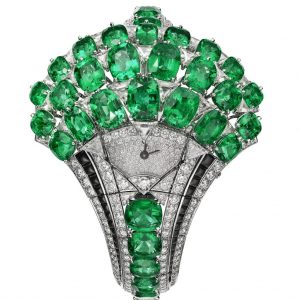The 1980s are making a comeback – shoulder pads, big hair, and now, the Panthère de Cartier.
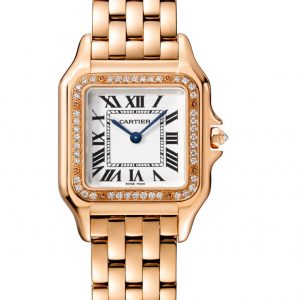
Cartier: Panthère de Cartier
Originally introduced in 1984, the Panther collection was the ultimate representative of the signature Cartier motif, even though it was perhaps the least literal interpretation. It was (and is again) a volume collection, with multiple references and price points, something the market seems to call for at the moment.
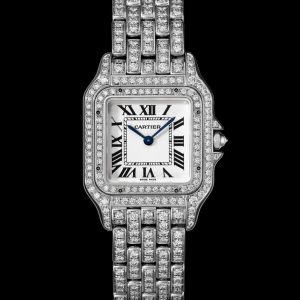
The design is exactly the same as the original: square case with screws on the bezel, Roman numerals, railway track index, and a tiny Cartier Replica logo embossed in the X digit – distinguishing it from the counterfeits. The line was discontinued in the early 2000s, and is being resurrected as a full collection in three sizes with a pavé version, a lacquer-and-gold jewelry edition, and a vintage-looking yellow-gold piece, with prices ranging from $4,000 to $140,000. Only the bracelet construction and the movements are new.
Cartier: Panthère Royale & Cartier: Panthère Joueuse
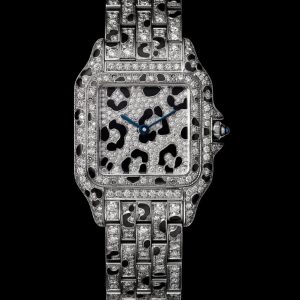
The Panther also made its annual appearance in high jewelry form at the SIHH this year, highlighted by the Royale and the Joueuse. The Panthère Royale (below) was inspired by a famous panther and sapphire brooch made by Cartier in 1949 for the Duchess of Windsor, designed in concentric circles set with diamonds surrounding a panther set with diamonds.
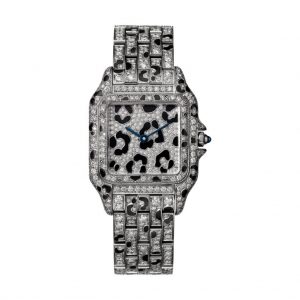
The panther on the Panthère Joueuse (below) is depicted with an outreached paw that follows a diamond-set ball around the dial, as if playing with it. The ball indicates the hours, and the paw, the minutes. The panther is set with 254 brilliant cut diamonds with lacquer spots and emerald eyes. It contains a new complication, the automatic Caliber 9918.
Cartier: Rotonde de Cartier Minute Repeater Mysterious Double Tourbillon
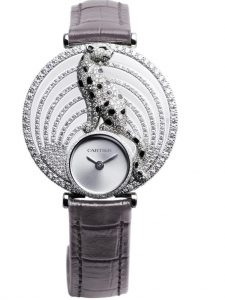
In recent years, Cartier has placed a focus on its fine watchmaking department, managed by watchmaking maestro Carole Forestier, in an endeavor to build the brand among male aficionados. Among Forestier’s innovative creations this year is the Rotonde de Cartier Minute Repeater Mysterious Double Tourbillon (below). It contains the Geneva Seal Caliber 9407 and combines Cartier’s iconic mysterious movement, combined with a minute repeater mechanism for the first time. The movement is treated with dramatic black rhodium plating. The tourbillon carriage, in addition to rotating once every 60 seconds, is lodged in a sapphire disk that completes one rotation every five minutes.
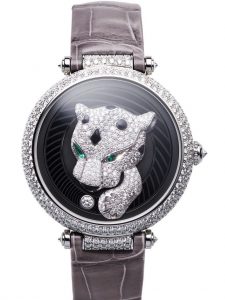
The minute repeater chimes on demand, with gongs and large hammers visible at 6 o’clock. When the repeater is activated, an inertia fly-wheel turns silently, ensuring a clear sound, free of the governor that regulates the chime. The square-profile gongs are made of hardened steel, which Cartier says creates a richer, more consistent sound, largely because with square gongs, the hammers hit a more precise surface.
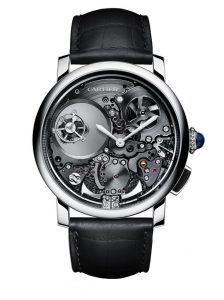
The watch is a limited edition of 50 pieces. Like all “mysterious” watches, the hands are not directly linked to the movement, but are joined to two sapphire disks that turn the hands – one for the minute hand and the other for the hour. The piece was inspired by Cartier mystery clocks, invented by the company in 1912.
Cartier: Trait d’Eclat & Cartier: Papyrus
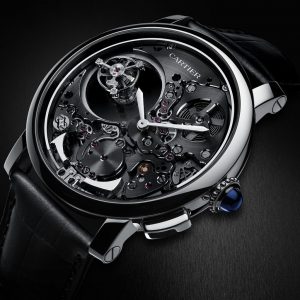
Cartier is famous for its annual prolific production of one-of-a-kind jewelry watches (20 were introduced at SIHH this week). One highlight is the Trait D’Eclat, set with 15 Mozambique rubies weighing a total of 24.93 carats, designed in a ribbon motif. The flash of fire produced by the gems is described in French as a “trait d’éclat.” It contains the manual-wound Jaeger-LeCoultre Caliber 101.
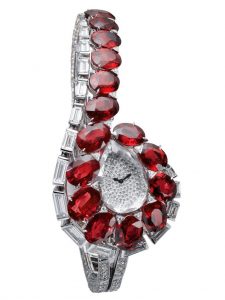
Another high-jewelry piece is the Papyrus, in 18k white gold and set with 32 cushion-shaped Zambian emeralds totaling 38.20 carats, along with onyx, triangular diamonds and brilliant-cut diamonds. It contains the manual-wound Caliber 846. The design is meant to resemble foliage, inspired by the papyrus plant motif in Cartier archival pieces. Two triangular shaped diamonds serve as “hour markers” at 12 and 6 o’clock.
